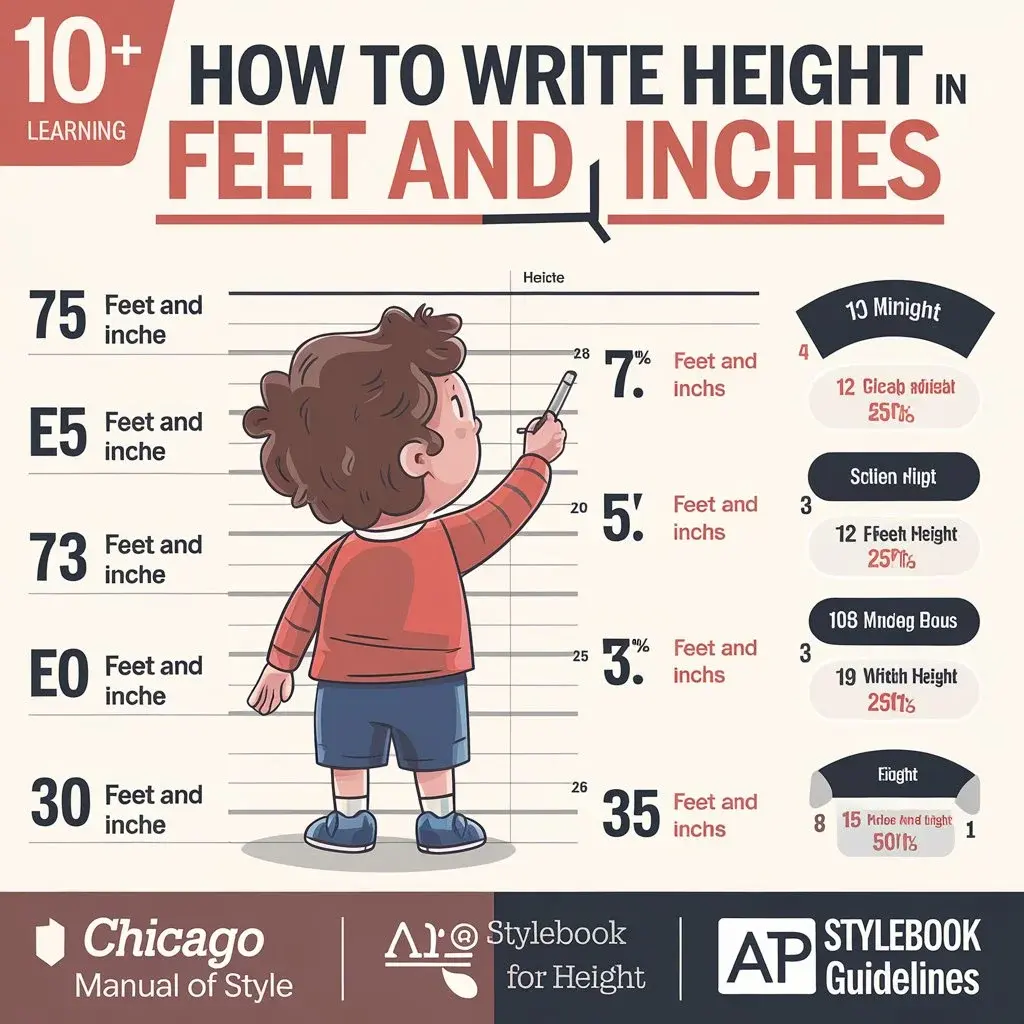One such example is knowing how to correctly write height in feet and inches. The question often arises: How do we write height in the correct format? This post will explore how to write height using both the Chicago Manual of Style and the AP Stylebook and highlight the differences between them.
There are plenty of language rules in English that we’ve encountered that seem to vary depending on which stylebook you use.
What Is the Best Practice for Writing Height in Feet and Inches?
The best way to write height depends on whether you’re following the Chicago Manual of Style or the AP Stylebook. According to the Chicago Manual, the correct way to write height is by using words for the numbers, such as “five feet, six inches” or “five-feet-six-inches” when used as an adjective. On the other hand, the AP Stylebook suggests that writing height in numbers is also acceptable, such as “5-foot-6-inches.” Both styles agree that you can abbreviate height as “5’6″,” where apostrophes represent feet and quotation marks represent inches.
Which stylebook you choose depends on your writing context, but the AP Stylebook tends to be more commonly used, especially in journalism and other forms of public writing.
How to Write Height According to the Chicago Manual of Style
Let’s take a closer look at how to follow the Chicago Manual of Style when writing height. According to this style, numbers should be spelled out in full. For example, instead of writing “5 feet 6 inches,” you would write “five feet, six inches.” This style generally avoids writing numbers as digits.
However, you only need to use hyphens when height is used as an adjective. This means that if the height is describing something directly, such as a person or an object, hyphens should connect the numbers and measurements. For example, “five-foot-six-inch girl” uses hyphens because it’s describing the girl’s height. Additionally, there should always be a comma separating feet and inches, like this: “five feet, six inches.”
Examples using the Chicago Manual of Style:
- She is five foot, six inches.
- The five-foot-six-inch girl is on her way.
- He is six foot, one inch.
- The six-foot-one-inch man is tall.
- I want to grow to be six foot, six inches.
- My brother is five foot, eight inches.
- The five-foot-eight-inch runner finished first.
- She stood at four foot, eleven inches.
- The four-foot-eleven-inch door was too short for him.
- He is now seven foot, two inches tall.
- The seven-foot-two-inch player dominated the game.
- The girl is five foot, three inches.
- The five-foot-three-inch statue was beautifully sculpted.
- He measures six foot, four inches.
- The six-foot-four-inch man was a gentle giant.
- She hopes to reach five foot, ten inches by next year.
- The five-foot-ten-inch model was on the runway.
- My dad is six foot, five inches.
- The six-foot-five-inch ceiling barely cleared his head.
- She stood at five foot, seven inches.
In the above examples, the difference between the descriptive form (without hyphens) and the adjective form (with hyphens) is clear.
How to Write Height According to the AP Stylebook
When writing height according to the AP Stylebook, the rules are straightforward but differ slightly from the Chicago Manual of Style. In AP Style, you are allowed to use numbers instead of spelling them out. This makes it easier to write heights in digits while keeping the formatting consistent.
Key Rules for Writing Height in AP Style
- Use Numbers for Height: Unlike the Chicago Manual, you should write height as digits. For example, write “5 foot, 6 inches” instead of spelling out the words like “five foot, six inches.”
- Commas Between Measurements: Always place a comma between the foot and inch measurements when describing height, e.g., “5 foot, 6 inches.”
- Hyphenation for Adjectives: When height is used as an adjective to describe someone or something, use hyphens between the numbers and measurements. For example, “5-foot-6-inch woman” or “6-foot-2-inch player.”
- Apostrophes and Quotation Marks: In informal writing, height can be represented with apostrophes for feet and quotation marks for inches. For example, “5’6” is acceptable to indicate 5 feet, 6 inches.
AP Style Examples:
- She is 5 foot, 6 inches.
- The 5-foot-6-inch girl is on her way.
- He is 6 foot, 1 inch.
- The 6-foot-1-inch man is taller than me.
- I want to grow to be 6 foot, 6 inches.
- My brother is 5 foot, 8 inches.
- The 5-foot-8-inch runner finished first.
- She stood at 4 foot, 11 inches.
- The 4-foot-11-inch door was too short for him.
- He is now 7 foot, 2 inches tall.
- The 7-foot-2-inch player dominated the game.
- The girl is 5 foot, 3 inches.
- The 5-foot-3-inch statue was beautifully sculpted.
- He measures 6 foot, 4 inches.
- The 6-foot-4-inch man was a gentle giant.
- She hopes to reach 5 foot, 10 inches by next year.
- The 5-foot-10-inch model was on the runway.
- My dad is 6 foot, 5 inches.
- The 6-foot-5-inch ceiling barely cleared his head.
- She stood at 5 foot, 7 inches.
Summary of AP Style Height Rules:
- Write the numbers as digits.
- Use commas between the foot and inch measurements.
- Use hyphens when height is an adjective describing a noun.
- Use apostrophes (‘) for feet and quotation marks (“) for inches in informal contexts like “5’6.”
The AP Style tends to be more informal and is commonly used in journalism and everyday writing.
As you can see, while the format may differ slightly, the rules are largely the same as those of the Chicago Manual, with the main distinction being whether you write the numbers as digits or words.
How to Choose Between the Chicago Manual and the AP Stylebook When Writing Height
Now that we’ve covered both stylebooks, how do you know which one to use? It largely depends on your writing style and the tone of your work.
The Chicago Manual of Style, which spells out numbers, is typically considered more formal. Therefore, it’s a good choice for academic papers, business documents, or formal writing. On the other hand, the AP Stylebook tends to be more informal, as it allows the use of numbers instead of words. This makes it more suitable for journalism, blogging, or any other casual writing.
An Informal Way to Write Height in Both Styles
There is another, more informal method for writing height, which is accepted in both the Chicago Manual of Style and the AP Stylebook. This method uses apostrophes and quotation marks to represent feet and inches. For example, “5’6″” is a quick and informal way of writing height. In this case, the apostrophe stands for foot and the quotation mark stands for inches. This style is often used in everyday writing but should be avoided in more formal contexts.
In conclusion, whether you choose the Chicago Manual of Style or the AP Stylebook depends on the context of your writing. Use Chicago Manual for formal documents and AP Style for everyday writing. Both styles allow for the informal version of height as “5’6″,” making it easier when you’re writing in a more relaxed setting.
FAQs
How do I write height in the AP Stylebook?
In AP Style, you should write height using numbers, such as 5 foot, 6 inches. If height is used as an adjective, like describing a person or object, add hyphens, as in 5-foot-6-inch girl. This style is commonly used in journalism and everyday writing. For informal contexts, you can also write height as 5’6″, using apostrophes for feet and quotation marks for inches.
Do I need hyphens when writing height?
You only need hyphens when height is used as an adjective to describe something, like a 6-foot-2-inch man. When height is simply a description, like “He is 6 foot, 2 inches,” you do not need hyphens. The use of hyphens is important to clarify that the height is modifying a noun, like a person’s description. In both AP and Chicago styles, this rule holds true.
Should I write numbers or words in AP Style?
In AP Style, height should be written as numbers, such as 5 foot, 6 inches, instead of spelling them out. This is different from the Chicago Manual, which prefers words like “five foot, six inches.” Using numbers in AP Style is considered more informal and quicker to read, making it ideal for news articles and casual writing. You should also spell out the units like foot and inches, but not the numbers themselves.
Is there a difference between Chicago Manual and AP Style for height?
Yes, there’s a notable difference between the two styles. In the Chicago Manual of Style, you must spell out numbers in words, such as five feet, six inches. In AP Style, you use digits, such as 5 foot, 6 inches, but the structure is similar in other aspects. Both styles agree on using hyphens when height is an adjective, as in five-foot-six-inch or 5-foot-6-inch.
Can I use apostrophes for height?
Yes, both the AP Style and Chicago Manual allow the use of apostrophes and quotation marks to represent feet and inches. For example, you can write 5’6″ instead of spelling out 5 foot, 6 inches. This method is considered more informal but is widely accepted for casual writing. Just be careful not to use this format in more formal documents or contexts.
What is the proper way to write height with feet and inches?
The correct way to write height depends on which stylebook you are using. In AP Style, you write it as numbers, like 5 foot, 6 inches, whereas in the Chicago Manual, you spell it out as five feet, six inches. Both styles require a comma between feet and inches and hyphens when height is used as an adjective. Make sure to know your audience and style guide when choosing between the two formats.
When should I use a comma in height?
You should always use a comma between the feet and inches when writing height, like 5 foot, 6 inches. This rule applies in both the AP Stylebook and the Chicago Manual of Style. The comma helps to separate the two measurements clearly, making the height easier to read. Just remember, this is required whether you’re writing in numbers or words.
Final Words
In conclusion, knowing how to write height correctly depends on the style guide you are following, whether it’s the AP Stylebook or the Chicago Manual of Style. In AP Style, you use numbers and hyphens when necessary, while the Chicago Manual prefers spelling out numbers in words. Both guides agree on using commas between feet and inches and applying hyphens when height is an adjective. By understanding these simple rules, you can ensure your writing is clear, consistent, and appropriate for the context you’re working in.

I’m Mira Sinclair, the expert helping you navigate grammar sections at “Grammer Grove.” Playing with words and expressions is my thing. At Grammer Grove, we’re here to make yourwriting stand out and shine. Let’s make your appreciation heartfelt and memorable—come and join the fun at Grammer Grove!












